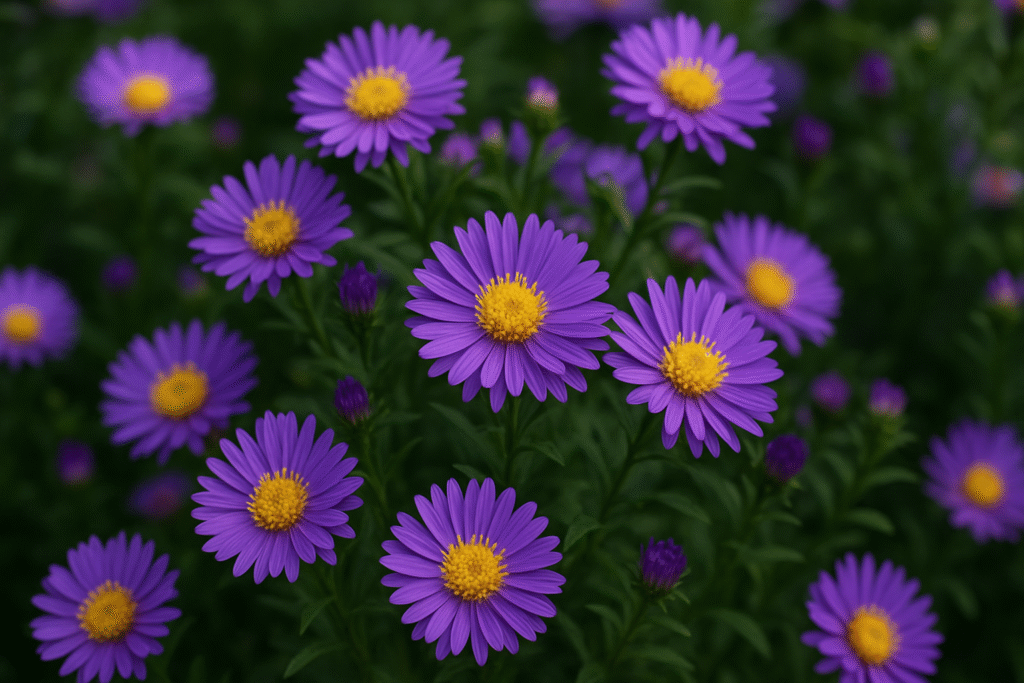As summer begins to fade and most flowers bow out of the seasonal spotlight, Aster plants step forward like nature’s encore — vibrant, resilient, and buzzing with life. These daisy-like blooms don’t just add color to your garden; they invite a whole ecosystem to thrive.
Botanical Background: More Than Just a Pretty Face
Once grouped under the genus Aster, many of these plants have now been reclassified into genera like Symphyotrichum, Eurybia, and Ionactis. But no matter the name, their charm remains timeless. Native to North America, Asters are perennial wonders that return year after year, stronger and more beautiful.
Pollinator Paradise
Asters bloom when most other flowers have faded, making them a lifeline for late-season pollinators. Bees, butterflies, and even migrating birds flock to their nectar-rich blossoms. Monarch butterflies, in particular, rely on Asters during their long journey south — a small flower playing a big role in a global migration.
Growing Guide: Easy Elegance
Want to grow Asters? You’re in luck — they’re as low-maintenance as they are lovely.
- Soil: Well-drained, slightly acidic to neutral
- Sunlight: Full sun to partial shade
- Watering: Moderate; avoid soggy roots
- Care: Deadhead spent blooms to encourage more flowering; divide clumps every few years to keep them vigorous
Whether you’re a seasoned gardener or just starting out, Asters are forgiving and generous companions.

Native Charm & Adaptability
Asters are native to many regions across North America, making them ideal for sustainable gardening. They blend seamlessly into wildflower meadows, cottage gardens, and even urban landscapes. Their adaptability means they can thrive in containers, borders, or rocky patches — wherever you need a splash of life.
Color & Form: Nature’s Palette
From soft lavender to deep violet, snowy white to blush pink, Asters offer a painter’s palette of hues. Some varieties grow just 20 cm tall, perfect for edging paths, while others stretch up to 2 meters, creating dramatic backdrops. Their star-shaped blooms seem to sparkle under autumn skies.
Garden Impact: More Than Just Beauty
Planting Asters isn’t just about aesthetics — it’s a quiet act of ecological kindness. They support biodiversity, stabilize soil, and extend the blooming season. In a world where native habitats are shrinking, your garden can become a sanctuary.
So this season, let Aster plants do what they do best — paint your garden with color, life, and purpose.
They’re not just flowers. They’re storytellers of the soil, whispering tales of resilience, beauty, and connection
FAQS:
Q1. Why are Aster plants called “painters of biodiversity”?
Aster plants bloom in late summer and autumn when most flowers have faded. During this crucial time, they provide nectar for bees, butterflies, and migrating birds, helping sustain a thriving ecosystem.
Q2. Are Aster plants easy to grow for beginners?
Yes! Asters are low-maintenance and beginner-friendly. They thrive in well-drained soil, prefer full sun to partial shade, and need moderate watering. With minimal care, they reward gardeners with vibrant blooms.
Q3. Do Aster plants offer ecological benefits beyond beauty?
Absolutely. While they add stunning color to gardens, Asters also support biodiversity, stabilize soil, and serve as a late-season lifeline for pollinators like monarch butterflies.
Q4. How can Asters be used in garden design?
Asters are highly versatile. They can be grown in containers, borders, wildflower meadows, or even rocky patches. Short varieties work well as edging plants, while taller ones create dramatic backdrops.
Q5. What colors and varieties do Aster flowers come in?
Asters display a wide palette of colors, including lavender, violet, pink, and white. Their star-shaped flowers sparkle beautifully under autumn skies, making them a true highlight of the season.

